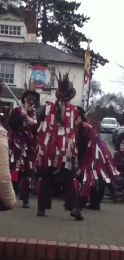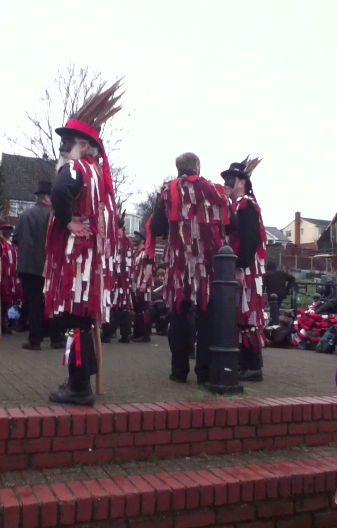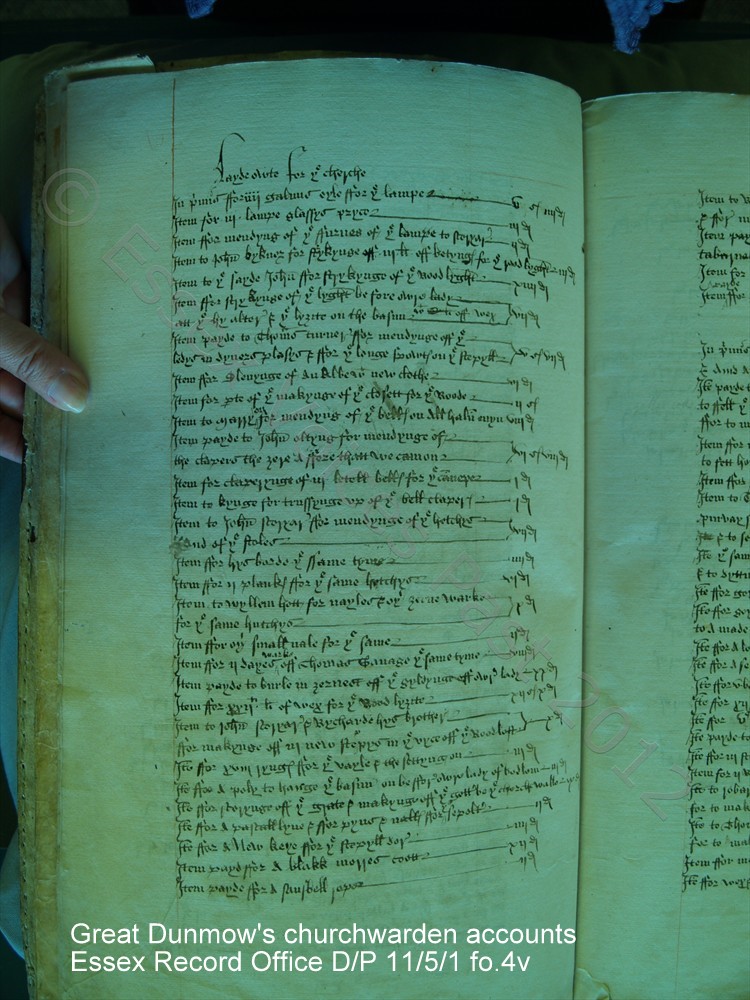Transcript fo. 4v: Great Dunmow’s Morris Dancing
Transcription of Tudor Great Dunmow’s churchwardens’ accounts (1525-6)
| 1. Layde owte for ye cherche [Laid out for the church] |
|
| 2. In p[r]im[s] ffor iiij galuns oyle ffor ye lampe [In primis (Firstly,) for 4 gallons oil for the lamp] |
vijs iiijd |
| 3. Item for iij lampe glassys pryce [Item for 3 glasses for the lamp, price] |
iiid |
| 4. Item ffor mendying of ye ffurnes of ye lampe to scoryar [John Scoryar – documented as paying ‘nichell’ (nothing) to the church steeple collection. Item for mending of the furnace of the lamp] |
iid |
| 5. Item to John bykner for stykynge of ye Rood lyght [Item to John Bykner for striking of the Rood Light] |
xiiijd |
| 6. Item ffor strykynge of ye lyght before owre lady [Item for striking of the light before our lady] |
|
| 7. att ye hy alter & ye lyght on the basun \?li <illegible> off wax/ [at the High Altar & the light on the basin] |
vijd |
| 8. Item payde to Thom[a]s turner ffor mendynge off ye [Item paid to Thomas Turner for mending the] |
|
| 9. ledys in dyvers plasys & ffor ye longe ?? ye stepyll [leds in divers places and for the long ?? the steeple] |
vs viid |
| 10. Item ffor slenynge[??] of ?? new clothe [Item for sewing? of ? new cloth] |
vjd |
| 11. Item for p[ar]te of ye makynge of ye closett for ye Roode [Item for making part of the closet for the Rood]. |
iis |
| 12. Item to Marry\ou/ for mendying of ye bells on all hall[o]ws evyn [John Mayor – documented as paying 4d to the church steeple collection.] [Item to Mayor for mending the bells on All Hallows Eve(ning)] |
viijd |
| 13. Item payde to John oltyng for mendynge of [Item paid to John Oltyng for mending of] |
|
| 14. the clapers the yere’d ffore thatt we cam on [the (bell) clappers the years (be)fore that we came on] |
vis viijd |
| 15. Item for claperynge of iij letell bells for ye can[n]epe [Item for ?? of 3 little bells for the canopy] |
id |
| 16. Item to kynge for trussyng up of ye bell clapper [Item to King for trussing up the bell clapper] |
id |
| 17. Item to John Scoryar ffor mendynge of ye hutchys [Item to John Scorya for mending of the hutches] |
|
| 18. <illegible> and of ye stoles [and of the stools] |
vijd |
| 19. Item for hys borde ye ssame tyme [Item for his board (ie accommodation/lodgings) the same time] |
iiijd |
| 20. Item ffor ij planks ffor ye same hutchys [Item for 2 planks for the same hutches] |
vid |
| 21. Item to wyllem hott for nayles for yeene wark [Item to William Hot for nails for ?? work |
|
| 22. for ye same hutchys [for the same hutches] |
xd |
| 23. Item ffor oyl small nale for ye same [Item for oil??? small nail for the same] |
iid |
| 24. Item for ij dayes \warke/ off Thomas Savage ye same time [Item for 2 days work of Thomas Savage the same time – Thomas Savage donated the largest amount of money for the church steeple £3 6s 8d] |
viijd |
| 25. Item payde to burle in yernest off ye gyldynge off Awr lady [Item paid to burle? in earnest?? of the gilding of Our Lady. |
xxd |
| 26. Item for xxijth li of wex for ye Rood lyrite [Item for 22 pounds (li = libra) of wax for the Rood Light |
xijs xd |
| 27. Item to John Scoryar & Rychard hys brother [Item to John Scoryar and Richard his brother] |
|
| 28. ffor makynge off iij new stepys in ye vyce off the Rood loft [for making of 3 new steps in the vice of the Rood Loft] |
xd |
| 29. Item ffor xviij ryngs ffor ye nayle & the settyng on [Item for 18 rings for the nails & the setting on] |
iijd |
| 30. Item ffor a poly to hange ye basun on before owr lady of bedlem [Item for a pole to hang the basin on before Our Lady of Bedlem (Bethleham)] |
iijd |
| 31. Item ffor scorynge off ye grate & makynge off ye got?? ye cherch walk? [Item for scoring off the grate & making off the ?? the curch walk?] | ixd |
| 32. Item ffor a parcall lyne & ffor pyns & nalls ffor \ye/ sepolk[er] [Item for a parcel line & for pins & nails for the sepulchre |
iiijd |
| 33. Item ffor a New keye ffor ye stepyll dor [Item for a new key for the steeple door] |
iiijd |
| 34. Item payd ffor a blakk morres coatt | xiid |
| 35. Item payde ffor a sansbell rope [Item paid for a sansbell (sanctus bell) rope |
ijd |
Commentary
Yet another fascinating page from Great Dunmow’s history with so many interesting items. On this folio, all the items are all expenses i.e. items purchased by the churchwardens on behalf of Great Dunmow’s parish church, as they were ‘Layde owte for ye cherche’.
Great Dunmow’s Black Morris Coat
One of the most important items on this folio is the entry 2nd from bottom.
- An expense of 12d for ‘a blakk morres coatt’.
This can be transcribed as being a ‘Black Morris Coat’. At some points in my research, I did wonder if this entry was actually a ‘Black Mores Coat’. However, the entry very definitely shows a double ‘r’ and reading the accounts in their entirety many times over helped me hear the voice of the scribe and understand the dialect of Tudor Essex. The double ‘r’ was meant to be pronounced, and this entry was certainly for a ‘Mor-ris’ coat, not a ‘Mores’ coat.
This entry for Great Dunmow’s Morris Coat has been much cited by historians of medieval and early-modern English drama, Morris Dancing, the Catholic ritual year, as well as English folklore. If you have read any of the secondary literature on these topics and themes, then you will invariable find reference to Great Dunmow’s ‘Black Morris’ coat. And this is the primary source entry for it! However, this is the one and only documented reference to ‘Morris’ or ‘Black Morris’ in the entire hundred years of the surviving churchwardens’ accounts. There are no other mentions.
The entry is very short and concise, so by using ‘Unwitting Testimony’, it could be surmised that the coat was not an extraordinary purchase but its cost was significant. According to Great Dunmow’s churchwardens’ accounts, a man’s labour for one day cost 4d. Therefore, the purchase of this coat for 12d was a noteworthy sum of money. Moreover, the accounts were very precise that this was just one coat: ‘a blakk morres coat’ (in the singular). This coat must have been quite a spectacular item – full of finery and regalia. Today’s East Anglian modern revival of Molly Dancing is a thought to be a throw-back from English traditions performed at May Day and Plough Monday. Perhaps Great Dunmow’s early-modern Black Morris coat was a very early version of the magnificent robes that now adorn the modern-day Molly Dancers of East Anglia. On the previous folio of the churchwardens’ accounts (fol.4r), both May Day and the Plough-fest were itemised as bringing in revenue into the church. Therefore, it was more than likely that this magnificent Black Morris Coat costing 12d was worn at either (or both) festivities.
Below are photos my son took of the Molly Dancers on New Years Day 2012 at The Hythe, Maldon.



Other items of interest on this folio
- Rood and Rood Loft;
- All Hallows Evening (the modern-day contraction of these words is ‘Halloween’);
- The image of Our Lady of Bedlam (Bethlehem);
- Sanctus bell (small hand-held bells)
- Lamp – whatever this lamp was, it must have been large as there was a substantial yearly maintenance cost for this particular year (1525-6). This folio documents the purchase of 4 gallons of oil for it, 3 glasses (or panes of glass) to go in it, and the mending of its furnace.
- Lights – several ‘lights’ (ie candles) are documented on this folio. These ‘lights’ (or candles) were all placed in front of a religious image or artefact. Henry VIII’s increasingly attacked traditional (Catholic) religion throughout the 1530s and eventually lights were banned before almost all sacred images. In Henry VIII’s 1538 Royal Injunctions (orchestrated by Thomas Cromwell), there were decrees against candles, tapers, and images of wax placed before any image or picture. Lights were only allowed before the rood, sepulchre, and sacrament of the altar.(1) Later folios of Great Dunmow’s churchwardens’ accounts show that the church had complied with those Injunctions as there are fewer expenses for ‘lights’.
Footnotes
1) Eamon Duffy, The Stripping of the Altars: Traditional Religion in England,1400-1580, (2nd Edition, 2005), p407.
Notes about Great Dunmow’s churchwarden accounts
Great Dunmow’s original churchwardens’ accounts (1526-1621) are kept in Essex Record Office (E.R.O.), Chelmsford, Essex, D/P 11/5/1. All digital images of the accounts within this blog appear by courtesy of Essex Record Office and may not be reproduced. Examining these records from this Essex parish gives the modern reader a remarkable view into the lives and times of some of Henry VIII’s subjects and provides an interpretation into the local history of Tudor Great Dunmow.
*-*-*-*-*-*-*-*-*-*-*-*-*-*-*-*-*
This blog
If you want to read more from my blog, please do subscribe either by using the Subscribe via Email button top right of my blog, or the button at the very bottom. If you’ve enjoyed reading this post, then please do Like it with the Facebook button and/or leave a comment below.
Thank you for reading this post.
You may also be interested in the following
– Index to each folio in Great Dunmow’s churchwardens’ accounts
– Great Dunmow’s Churchwardens’ accounts: transcripts 1526-1621
– Tudor local history
– Pre-Reformation English church clergy
– Medieval Essex dialect
– Pre-Reformation Catholic Ritual Year
© Essex Voices Past 2012-2013.

